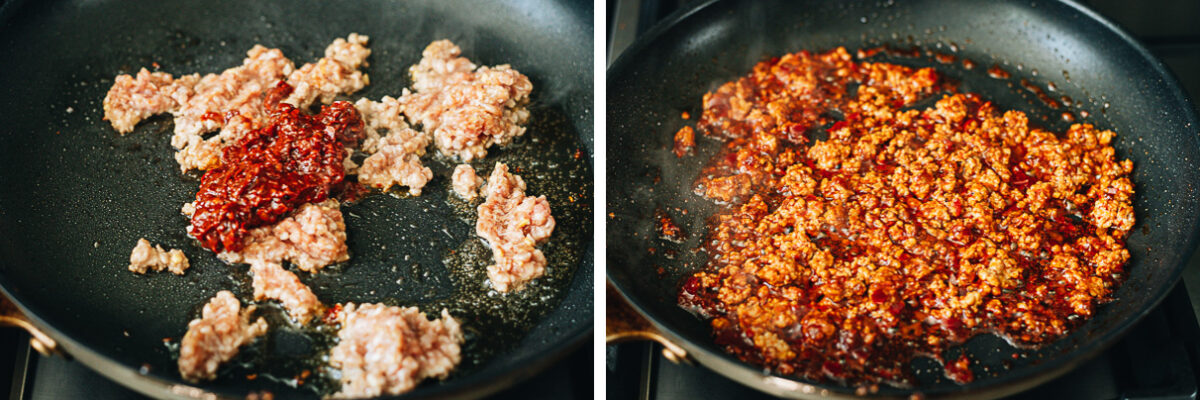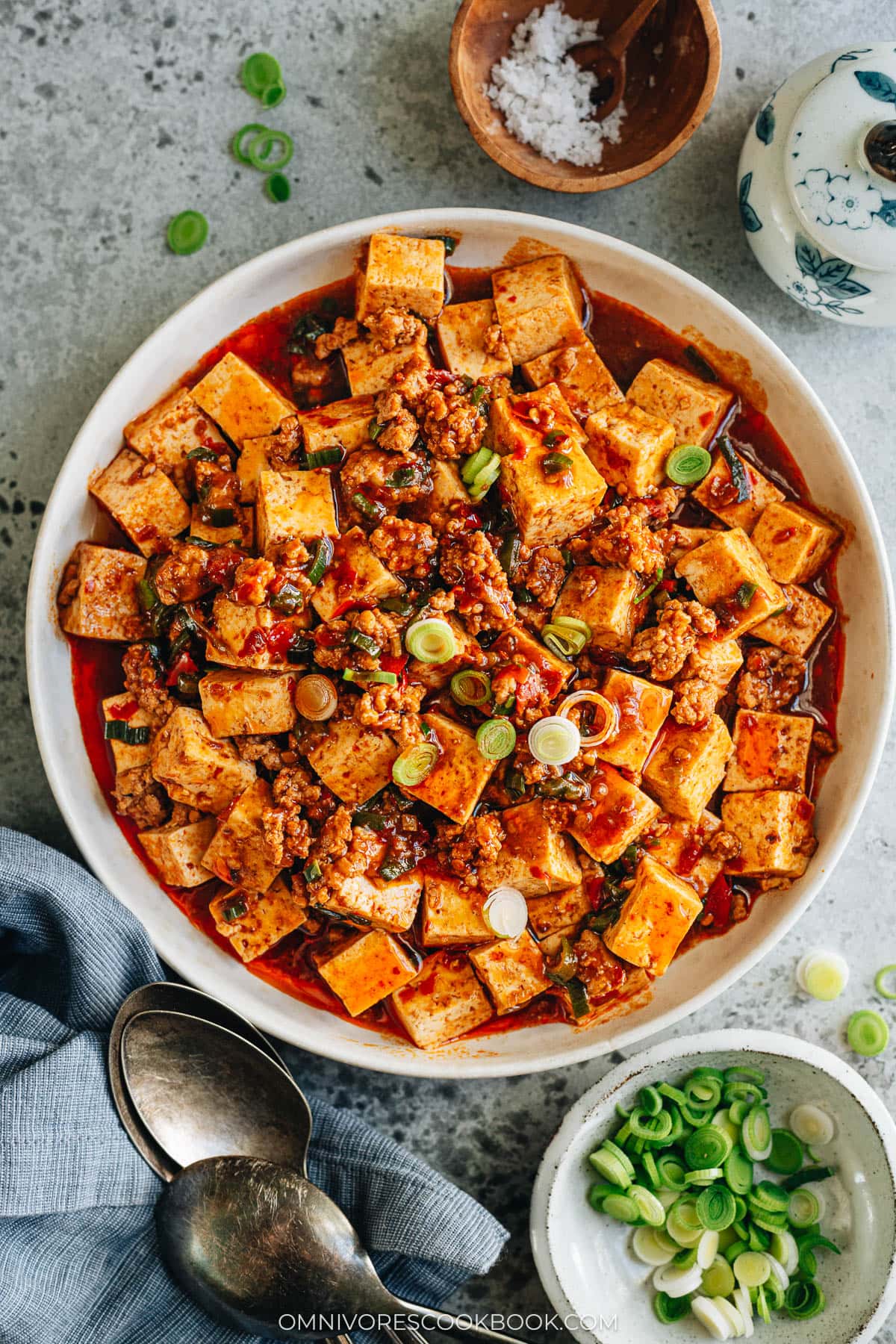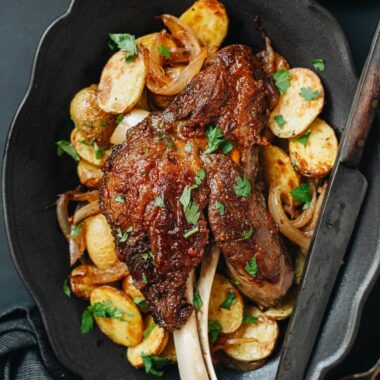
Mapo tofu (麻婆豆腐, ma po dou fu) is one of the most popular dishes from Sichuan cuisine. The tofu pieces are braised in a rich, spicy, savory sauce, along with fresh garlic and scallions. A small amount of ground pork enhances the flavor. The dish is so appetizing, and it goes perfectly with steamed rice.
Cooking mapo tofu is relatively easy, but you need a few special ingredients to get the authentic flavor. I’m sharing my favorite mapo tofu recipe below. It creates the very authentic taste that you’d get at a restaurant in China. However, you can easily tweak the dish according to your preferences.

Key ingredients for Mapo Tofu
Doubanjiang
Doubanjiang (豆瓣酱), also known as spicy fermented bean paste, chili bean paste, chili bean sauce, or broad bean sauce, is the most crucial ingredient in mapo tofu. It has a strong, fermented, savory, salty, and spicy taste. Try to find “Pixian Broad Bean Paste” at your Asian market.Pixian is a small county in the Sichuan province that produces the best chili bean paste. If you’re using this brand, you’re already halfway there. You can also purchase this brand on Amazon here.
NOTE: The salt and spice level can vary greatly depending on the Doubanjiang brand. This dish is designed to be served with rice, so it’s on the salty side. To make your dish less salty and spicy, reduce the amount of Doubanjiang to 2 tablespoons.

Sichuan peppercorns
Sichuan peppercorn (花椒, hua jiao) is another main ingredient in any Sichuan dish. It has a citrusy taste with a numbing tingling sensation when you chew on it. It’s a crucial and irreplaceable flavor-enhancing ingredient.. You can purchase Sichuan peppercorns at Asian grocery stores, but I highly recommend these premium fresh ones from The Mala Market.

Sichuan peppercorn cooking tips
The most common way to cook Sichuan peppercorns is to fry them in hot oil. Doing so infuses the flavor and makes the dish milder. You can also grind the peppercorns and use them to garnish your dish later.
Alternatively, you can use ground-up fresh Sichuan pepper. I recently got a Sichuan peppercorn grinder from The Mala Market. I love that it’s fast and easy to use. Grind a small amount and add it when cooking or at the end to add flavor. If you have this product on hand, add 1/4 teaspoon ground Sichuan pepper when you add the ground pork.
When you use super fresh Sichuan pepper, the flavor is pungent. You may only need about half of the amount indicated in this recipe. The longer you store the peppercorns, the less fragrance they will have, and the more you need to use.
Homemade chili oil
The other essential ingredient is homemade chili oil (辣椒油). Freshly cooked chili oil tastes much better than store-bought and is free of additives. It only takes a few minutes to cook, and it’s really easy.
If you want to purchase chili oil, make sure to find a high quality one. And it should contains chili flakes and the oil, such as this one.
What to do with leftover chili oil?
You will usually cook more chili oil than you’ll use in one meal. You can store the extra oil in an airtight container in the fridge for 6 months to a year. Use it in various dishes, including Sichuan spicy wonton in red oil and Fu Qi Fei Pian (sliced beef in hot sauce). You can also add it to a dipping sauce for potstickers, to wonton soup to enhance the flavor, or even put it on oatmeal!
It might look like you need so many specialty ingredients for this one dish. But trust me, if you love Sichuan food, you’ll use them repeatedly.
How to cook mapo tofu
Fry the Sichuan peppercorns in the oil to infuse the aroma
- Fry the Sichuan peppercorns in the oil to infuse the aroma.

- Cook the ground pork with doubanjiang.
- Once the pork is cooked, add the green onions and stir a few times.

- Add the broth, tofu cubes, and braise with the cover on.
- Drizzle in the cornstarch mixture to thicken the sauce. Sprinkle with scallion greens for garnish.

That’s it! I think this is one of the easiest Sichuan recipes, and the result is super rewarding 🙂

How to serve mapo tofu
I love cooking mapo tofu for a quick lunch or dinner and serving it over steamed rice. Sometimes I double the meat and sauce, so it will be enough to serve two people as a one-dish meal.
I also like to add a handful of greens (spinach, garlic chives, or other tender greens such as chopped up baby bok choy) at the end of braising before adding the cornstarch, to create a more nutritious and balanced meal. Sometimes I also replace the ground pork (used in the authentic version) with ground beef, or ground chicken, depending on what I have in the fridge.

Frequently asked questions
What type of tofu should I use for mapo tofu?
There is no correct answer; you should choose what works best for you. Some Chinese restaurants, including many in China, prefer soft or silken tofu for a melt-in-your-mouth texture. This method requires some experience handling tofu, so you won’t break apart the delicate silken tofu while cutting and cooking.
This dish can also use extra firm, firm, or medium tofu, which is much easier to handle. Plus, once you braise the tofu in the rich, spicy sauce, it absorbs a lot of flavor and tastes great.
Do I need a wok to cook mapo tofu?
Not at all! I found it’s easiest to cook mapo tofu in a nonstick pan. The tofu will sit flat in the broth and absorb all the flavor. Plus, it won’t stick to the pan or fall apart when you stir it.
Can you recommend a gluten-free doubanjiang?
Doubanjiang usually contains fermented wheat, which is not gluten-free.
There is a gluten-free Japanese brand of doubanjiang, and I see it quite often at Asian markets and on Amazon.
Compared to the Chinese brand, this one is quite salty and has less of a fermented taste. If you decide to use this one for your mapo tofu, you should reduce the amount (to 2 tablespoons) so your dish won’t be too spicy and salty.
How do you make mapo tofu vegetarian or vegan?I have a vegan mapo tofu recipe here that tastes super flavorful!
Chinese Cooking Made Easy
Are you new to this website? This free email series is a great place to start. I’ll walk you through a few of my most popular recipes and show you how and why they work. You’ll quickly start to cook better Chinese food in your own kitchen.

Authentic Mapo Tofu (麻婆豆腐)
Ingredients
Marinating
- 4 oz ground pork (or chicken, or turkey) (*Footnote 1)
- 2 teaspoons Shaoxing wine (or dry sherry)
- 1 teaspoon light soy sauce
- 1/2 teaspoon minced ginger
For braising
- 1 teaspoon cornstarch (optional) (*Footnote 2)
- 2 teaspoons Sichuan peppercorns , increase to 3 teaspoons if you like your dish extra numbing, or reduce to 1 teaspoon if your Sichuan peppercorns are extra fresh
- 1 tablespoon peanut oil (or vegetable oil)
- 3 tablespoons Doubanjiang , reduce to 2 tablespoons for a less saltier and less spicy taste
- 2 green onion , chopped
- 1 block firm or medium firm tofu , cut into 1.5cm (1/2 inch) squares
- 1 cup chicken stock (or water)
- 2 teaspoons homemade chili oil (*Footnote 3)
- 1/4 teaspoon five-spice powder
- 1 teaspoon sugar (or to taste)
Instructions
- Combine ground meat, cooking wine, soy sauce, and ginger in a small bowl. Mix well.
- Combine cornstarch with 1 tablespoon of water in a small bowl. Mix well and set aside.
- Heat the oil and Sichuan peppercorns in a large nonstick skillet over medium-high heat. When the Sichuan peppercorns turn dark brown and crispy, scoop them out with a spatula and transfer into a bowl layered with paper towels to soak extra oil. Save to use for garnishing the dish (Optional).
- Add the ground meat and Doubanjiang. Cook over medium heat and chop the ground meat into small bits with a spatula, until pork is evenly coated with Doubanjiang and fully cooked through. Add green onion and stir fry for another minute.
- Spread tofu evenly on top of ground pork (*Footnote 4). Add chili oil, five-spice powder, and sugar. Pour in the broth and cook until brought to a simmer. Simmer, covered, over medium-low heat for 8 to 10 minutes, or until the sauce has reduced to half the original amount. Taste the tofu with some broth (be careful, it will be very hot!). Adjust seasoning by adding salt if needed. If the dish is too spicy, add another teaspoon of sugar to balance it out. Gently mix well with spatula.
- (Optional) Meanwhile, grind the fried Sichuan peppercorns (you used when heating up the oil) in a coffee grinder or using mortar and pestle.
- Mix cornstarch water again until fully dissolved and swirl it into the skillet. Gently stir a few times with a spatula, until sauce thickens. Turn off heat and transfer everything to a bowl.
- Garnish with extra green onion and a small pinch of the ground Sichuan peppercorns, if using (*Footnote 5), if using. Serve hot over steamed rice or by itself as main.
Video
Notes
- You can skip the meat and make this dish vegetarian. In this case, I highly recommend replacing the meat with mushrooms (such as rehydrated dried shiitake mushrooms) to enhance flavor.
- If you like the tofu with more broth, you can braise the tofu for a shorter time and use the cornstarch slurry to thicken the broth. Alternatively, you can uncover and braise until most of the liquid evaporates. The tofu will absorb more flavor this way.
- You can also pour on more chili oil for the restaurant look!
- Do not stir the tofu immediately after adding it into the skillet, in order to keep the pieces from breaking apart. The tofu will get firmer after braising and you can stir it once it’s cooked.
- The Sichuan peppercorns add a numbing nutty aroma to the dish. The fried Sichuan peppercorns have a more rounded body so it works great for garnishing the dish or in a salad. You only need a small amount in this recipe to finish up the dish. Store the rest in an airtight container, no longer than a month.
Nutrition
Have a question or feedback? Add a Comment
Did you make this? I want to see! Tag @OmnivoresCookbook on Instagram, and rate the recipe below.




Klumsy K
Coming from sauce packets, this is like a door into a whole another world. Very tempting 🙂
Lydia
This was ohhhh so good! The only substitutions I made was I replaced pork with plant based pork (and it worked wonderfully!! I also used a sugar substitute instead of sugar. It wasn’t as spicy as I thought it would be. OH I also did not have homemade chili oil and used store bought. Despite these changes, it was so very delicious and I cannot wait to make it again!! Thank you!
HolySnom
This recipe rocks. It’s pretty much exactly how I remember it tasting in China. I wouldn’t change a single thing about the recipe.
Yvonne
Wonderful recipe!! I have a texture thing with the slippery tofu, one of our Asian shops sells fried tofu in baggies as well as homemade kimshi .. the tofu is very firm, ( I just eat it out of the bag!). So I make the dish and add tofu towards the end of the sauce reduction to keep the firmness. Thank you!
Sarah Jane
I made this without the pork and it was fire! And it was just as quick as the recipe said
Lev T
I make this recipe practically once a week, I love it so much! It’s so easy to cook with a relatively small amount of prep time. You just need a few specialty ingredients and you’re basically set. Awesome job!
Clark Walkup
This recipe was absolutely delicious! I’ve never like tofu before, but I think this recipe changed my mind.
Fredrik Forsberg
Tasty and easy to follow. Although I used the lesser amount of Doubanjiang and more pork.
If I would have done iy “my way” I would have added the cooking wine and soy sauce after braising the pork.
Neil
I made this for my wife and we both really liked it. I found it a bit salty which is likely due to the salted wine (I didn’t have unsalted on hand) and the Lee Kum Kee doubanjiang. We both agreed that it seems to need something to brighten it up a touch, but I’m not sure what. We put a bit of lemon juice on it afterwards and that seemed to help though it’s still not quite right.
Other than that, it’s the first dish where I actually liked tofu!
Mike C
Winner! Awesome dish, easy to follow instructions.
Kirstine Majlund
Everytime I pull myself together, and actually*follow* one of your recipes – I get amazed. Although, I didn’t have authentic Sichuan peppercorns, I still made it work, and it was incredible. How would’ve thought that I could be making traditional Sichuanese cuisine in my humble Danish kitchen.
PS: even my potato-eating, spice-phobic Danish mom, enjoyed this meal, yay!
John Wootton
Pixian bean paste not supplied by Amazon any more (Europe)
Michael
First success with tofu! Not a vegetarian, but I did the dish that way. Took a note from another vid about tofu; you have to get the water out, otherwise, it won’t absorb flavor. Even with extra firm, squeezing means the curd will break, so, I took a hint from another chef; freeze it; that will pull out the moisture. Not sure if this made the dish work, but it I’d bet on it!
Bob Herring
Have made this recipe several times; last night was the latest time, and the best.
I used firm tofu and browned it in the oven for 45 minutes. Added it to the sauce and braised for another 15 minutes bi find the doubanjiang sauce to be excessive in terms of salt, so I adjusted it accordingly. I used your recipe for chili oil, and it was great, in moderation. I served this with brown rice and steamed broccoli. Very tasty! Thank you for your authentic tastes of China. I am a regular fan b
Rona Deis
I really like how you cook, simple and fun.
Nick
Hi Maggie. This looks great: thanks for posting it! One question – the dish LOOKS like it has black beans in it but they’re not listed in the ingredients. Are the black beans part of the doubanjiang?
Maggie Zhu
Hi Nick, this recipe does not use black bean sauce. The dark beans are the ones from doubanjiang.
That being said, it is very delicious to add black bean sauce to the dish if you have any on hands. I would replace 1 tablespoon doubanjiang for black bean sauce.
Mark
This was tasty and outside of the typical Chinese restaurant food. I substituted chili oil with fermented soy beans and black bean garlic sauce? Tasted good! Can’t stop with your wonderful recipes. Had this with Chinese garlic eggplant, my absolute favorite. And grilled pork(not all vegetarians). Thanks!
Adrienne
This was my first ever attempt at Mapo Tofu. So good, I can’t imagine trying another recipe for fear of disappointment
Lisa G
Authentic, So Yummy! I have traveled all around China and other Asian countries and mapo tofu is hard to find in restaurants here in the US. When I do find it, 9 times out of 10 it isn’t as good. So I decided to try making it myself. I saw lots of recipes and decided a few years ago to go with this one. And I am SO GLAD I did! It tasted like I remembered having it in China. So delicious! I have now made it for several years many times. I absolutely LOVE it! Highly highly recommend. Now I see its been updated this year with more pictures so I will follow again as per the updates. Now I will try out the Congee and other recipes. I am so happy for you and your site thank you SO MUCH for your expertise, excellent directions, and delicious recipes!!!! Big fan!
Melinda
Delicious!!